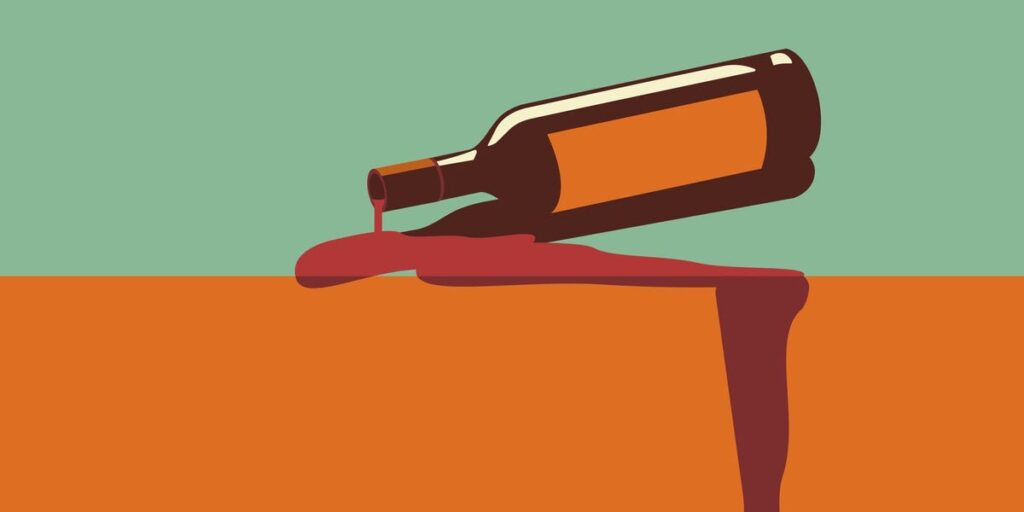- For the first time, a randomized controlled trial showed Ozempic curbs alcohol cravings.
- Researchers say this opens the door to researching microdosed Ozempic for alcohol dependence.
- Scientists are racing to identify the brain pathway involved to unlock new addiction treatments.
A major new study on weight-loss drugs poses a new idea for addiction treatment: small doses of Ozempic could help people cut down on drinking and smoking.
This week, JAMA Psychiatry published the results of a small but significant trial that showed a similar effect on alcohol cravings. For two months, 48 people with alcohol use disorder were given either a small weekly shot of semaglutide, the active ingredient in Ozempic and Wegovy, or a placebo. Those who received the drug drank less and reported fewer cravings.
The federally-funded study is the first randomized controlled trial — the gold standard of clinical research — looking at Ozempic and alcohol cravings, after years of reports from Ozempic users that they feel less attached to alcohol.
There was a bonus finding, too. Cigarette smokers who received a dose of semaglutide reduced their daily cigarette consumption more than those who got the placebo.
Researchers say the results open up a whole new world of possibilities for drug developers. Could we manufacture a new, smaller dose of GLP-1 drugs that people can use to break habits?
“I could absolutely see microdosing come into play,” Gregg Stanwood, a behavioral neuroscientist at Florida State University who was not involved in the study, told Business Insider.
“That could be a good thing if someone does it and successfully has a Dry January and maybe they go back to drinking in February, but it reduces binges and they go into something that’s more sustainable for everyday life.”
We still have major questions about what that could look like. Further trials are needed with different doses, a longer period of time, on more people.
Still, scientists are buzzing about this trial, what it teaches us about our brain’s reward system, and the drug-development potential.
Here are a few reasons for intrigue, according to three researchers:
A vacuum cleaner for dopamine
We still have a lot to learn about how GLP-1 drugs work on the brain, though studies on alcohol offer some clues.
It’s tempting to think that, because semaglutide can help people cut down on calories and sugar, it similarly reduces the “appetite” for alcohol. It’s not that simple, Anders Fink-Jensen, professor of psychiatry at the University of Copenhagen who’s researched the effect of GLP-1s on substance use disorders, told BI.
For example, animal studies showed that GLP-1 drugs not only reduced alcohol cravings in mice, but also slowed down the urge for a fix in rats who were craving cocaine, which is calorie-free.
“We know quite little about it,” Fink-Jensen told Business Insider. “We just don’t really know how the drugs get there. There are areas for regulating appetite and we know it reaches these areas. But how it gets to the rest of the brain, we don’t really understand.”
One theory is that GLP-1 drugs mitigate dopamine rushes in the brain, the feeling of pleasure triggered by certain behaviors like eating candy or sipping expensive whiskey.
It does that by boosting a specific type of protein through complex cellular processes scientists are still working out.
“It acts as a vacuum cleaner for dopamine, basically sucks the dopamine up,” Stanwood told Business Insider. “Rewards like drinking, gambling, sex, share a mechanism to increase the amount of dopamine in your brain. Cleaning up the excess dopamine reduces incentive for those behaviors.”
The race to explain this brain effect — to unlock a whole new drug market
There is huge potential for this area of research. Whoever can explain what, exactly, GLP-1s do to the brain will be the toast of the pharmaceutical industry. Treatments could be developed for alcohol use disorder — and so much more.
“Addictions in general, also functional addictions such as gaming addiction,” Dr. Markku Lähteenvuo, a researcher from the University of Eastern Finland who specializes in how drugs affect the brain, told BI.
So, the race is on. Central dopamine regulation is “the most rooted for” theory, Lähteenvuo said, but there is no shortage of research teams looking for other explanations.
It’s hard to assess the safety of such treatments without understanding quite how drugs like Ozempic work in the brain, though.
“The question is, does GLP-1 receptor activation do this all the time or just when dopamine is excessive?” Stanwood said. “If it’s all the time, that could be a problem because we need these dopamine hits to reinforce these wonderful things like hugging your kids, listening to music, having chocolate cake. We don’t want to clamp that down to nothing.”
So far, research is supportive of the theory that GLP-1s act on excessive dopamine levels. A key finding of the latest study is that participants didn’t stop drinking entirely, or even less often, but they were less likely to drink heavily and fewer drinks per session when they did.
Why you really (really!) need to consult a doctor before trying this
In the future, it’s feasible that GLP-1s may be a tool for people to manage their drinking.
The tricky part is safety.
Stigma around addiction could scare off investors from developing a GLP-1 for substance abuse disorders, researchers told BI. Ozempic has other lucrative and appealing applications for which companies could develop next-gen medications, like preventing heart attacks or kidney disease.
“It could easily take three or four years or much longer if they’re not interested or if data are not so positive as we hope them to be,” Fink-Jensen said.
People can — and do — take GLP-1s off-label for weight loss, finding Ozempic (technically a diabetes drug) from gray market websites. Fink-Jensen said it’s a risky move, even under supervision, since we don’t yet understand exactly how to use this drug for addiction.
“We really suggest that people should avoid prescribing these compounds now and wait for more strong data.”
- Morgan McFall-Johnsen contributed reporting.
Read the full article here
















